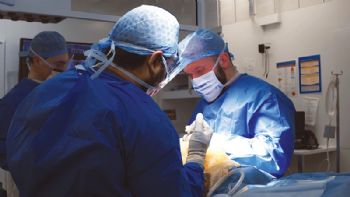
During the 1980s, the medical profession ‘embraced’ titanium as the material of choice for implants, as numerous studies highlighted this material’s osseo-integration characteristics — the direct structural and functional connection between living bone and the surface of a load-bearing artificial implant.
Further research highlighted the positive impact of textured functional surfaces on such osseo-integration.
Compared to smooth ‘as machined’ surfaces, it was posited that texturing not only improves bone integration — and thus implant stability — but also allows for the growth of supportive tissue, and it may even provide antibacterial advantages.
Today, the ‘gold standard’ for titanium implants features such textured surface on all areas where integration with bone needs to take place, and such surfaces are now found on a range of devices such as bone plates and hip joints, as well as cervical and dental implants.
That said, determining the optimum values for surface roughness for a given set of conditions is expected to remain an area of focus for several years to come.
Although in the past, roughness was mostly described by the two-dimensional Ra value (a measure of the variation in height), three-dimensional measurements — including the arithmetical mean height of the surface (Sa), texture aspect ratio (STr), interfacial area ratio (Sdr), core void volume (Vvc) and valley void volume (Vvv) — are now commonly used to describe a desired end result.
Textured surfaces have traditionally been achieved by grit blasting alone or in combination with chemical etching (the latter combination is probably the most widely used current approach).
The etching process involves using a strong acid to erode the surface area after blasting, resulting in microstructures from one to several microns in diameter.
A neutralisation phase in which the acid is reduced by ‘the addition of a base’ or multiple washing cycles completes the process.
However, etching is both time- and temperature-sensitive; it also requires the appropriate infrastructure to handle both dangerous chemicals and the waste by-products.
Moreover, both processes result in a random distribution of surface features — and the residue from blasting is difficult to remove entirely.
Seeking alternatives
These issues have prompted device manufacturers to look for alternative ways to achieve the required textured surfaces without secondary washing, while having ‘design flexibility’ with regard to surface properties — hence the introduction of laser texturing, which replaces the hitherto ‘random’ processes with a ‘digital’ one that sees pulses of laser light (often delivered with a nitrogen or argon shield gas) directed at the material’s surface.
Martin Spencer, managing director of Coventry-based GF Machining Solutions Ltd (
www.gfms.com/uk) — a manufacturer of laser texturing machines, such as the Laser P 4500U — says the laser heats and modifies the metal, creating local surface deformation.
The pulse duration — measured in nano-, pico- or even femto-seconds — is very short, while the impact location and pattern are precisely controlled.
This level of control means that the end result is repeatable (it is not dependent on operator judgement but is programmed into the controller) and clean (no particulate is generated, and little or no chemical change occurs to the metal).
Moreover, the process does not use consumables such as blasting materials or acids, bases or washing systems; neither does it require secondary handling, part masking or (in most cases) any secondary cleaning — or 100% final-product inspection.

Indeed, the use of laser texturing allows a surface to be structured/textured with a precise repeatable pattern, thereby enabling product designers and manufacturers to both ‘design in’ and meet more-exacting specifications for roughness.
Multiple different textures can readily be applied on the same device, and ‘elements’ such as 2-D bar codes or other device identification features can be easily integrated.
Furthermore, manufacturers concerned with counterfeiting can use proprietary textures; they can also incorporate logos or hidden patterns that confirm the device origin.
Meeting requirements
The choice of laser texturing technology (pulse duration, power and texturing pattern) will be driven by the surface that the manufacturer wants to produce; and because lasers that operate with a nano-pulse duration will both ionise metal and locally heat the surface being treated, the resulting surface will feature an increased Sdr, Vvc and Vvv (compared with femto-second lasers).
Being much shorter, femto-second pulses essentially eliminate the resulting heat-affected zone and give a surface with lower variation.
That said, both technologies are useful, and the choice of which to use depends on the required end result of the surface in question.
However, most textured surfaces are not flat but have complex curved geometries, and a key factor in the quality of a laser-textured solution is the ability to optimally compensate for these curved surfaces.
GF Machining Solutions says that while most commercially available systems introduce errors when applying a texture to a curved geometry, its laser-texturing machines use advanced software that “accommodates the texturing of even the most complex surfaces”.
In conclusion, GFMS says: “While the use of texturing on functional surfaces in order to speed bone growth and provide other patient benefits — through processes that include blasting, chemical etching and laser texturing — is well documented, blasting and etching create a random surface and increase both cost and risk by requiring multiple part handling and cleaning operations, as well as the use of consumables.
“A functional surface that is produced using laser light and an appropriate shield gas — under a digital process — results in a repeatable and structured functional surface that is essentially identical for all parts being made.
“Moreover, the ability of a laser texturing solution to correctly adapt textures to curved surfaces is also a specific strength and a clear differentiator.”